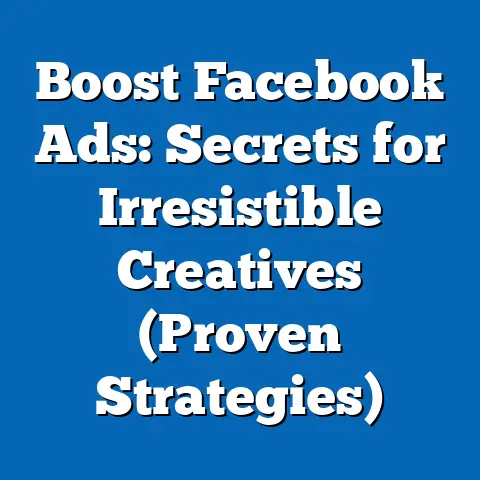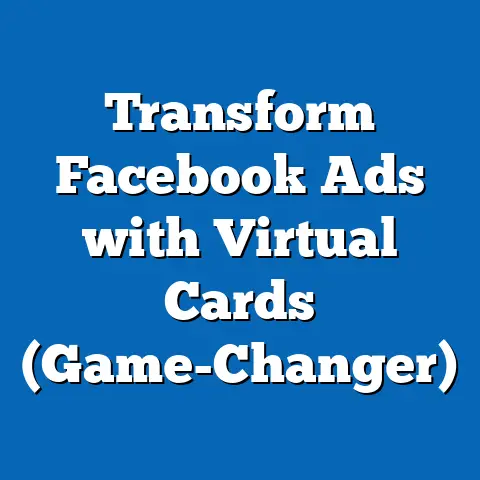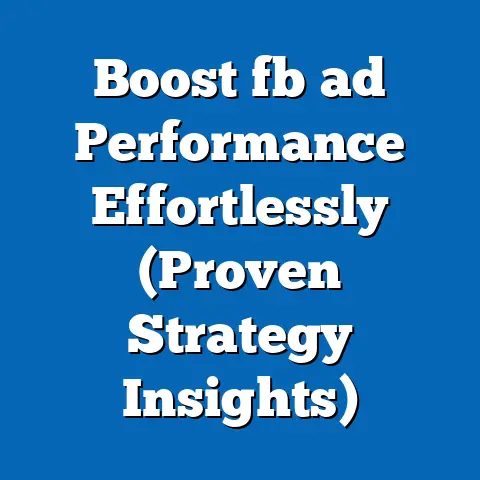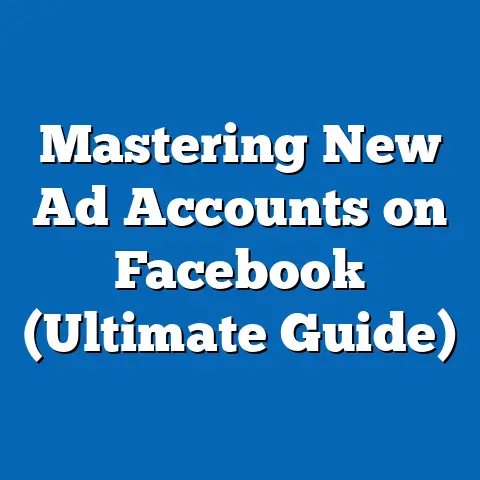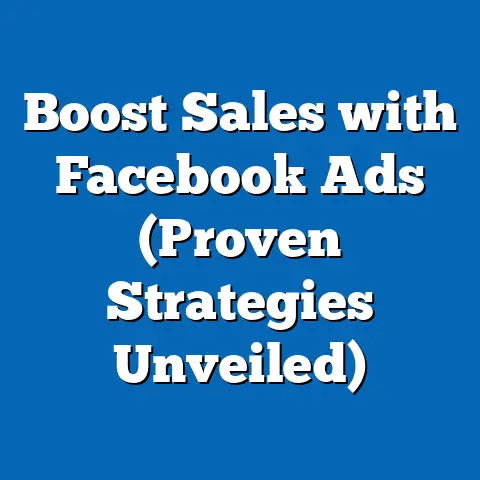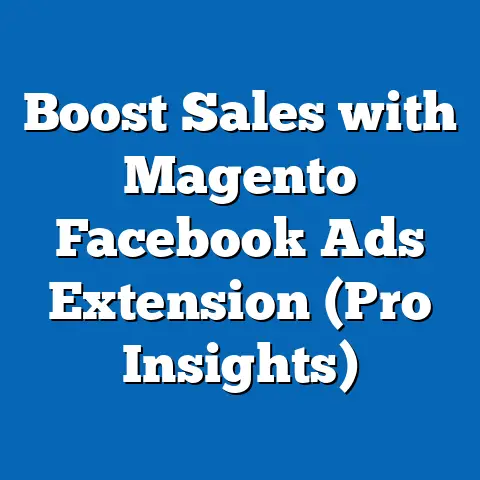Maximize Facebook Ads with Email Marketing (Expert Strategies)
In a world where digital noise is louder than ever, how can brands ensure their Facebook ads stand out and drive conversions? I’ve seen firsthand the struggle marketers face. The average user is bombarded with countless ads every single day, creating a real challenge to cut through the clutter and grab their attention. You can’t just throw money at Facebook ads and expect magic to happen. That’s why I want to talk about something that can significantly boost your Facebook ad performance: email marketing.
While Facebook ads are a powerhouse for reaching potential customers, integrating them with email marketing creates a synergy that can supercharge your results. It’s not just about running ads; it’s about building relationships, nurturing leads, and driving conversions in a way that resonates with your audience. In this guide, I’ll walk you through expert strategies that combine these two powerful channels to achieve superior results, drawing from my own experiences and observations in the field.
Understanding the Synergy Between Facebook Ads and Email Marketing
Facebook ads and email marketing, at first glance, might seem like separate entities. However, when strategically combined, they create a powerful force in your digital marketing arsenal. Think of Facebook ads as your initial outreach – the way you introduce your brand to a vast audience. Email marketing, on the other hand, is your follow-up, your way of nurturing those initial connections and guiding prospects further down the sales funnel.
Facebook Ads: The Broad Reach
Facebook ads excel at reaching a wide audience based on demographics, interests, and behaviors. I’ve used them to target very specific niches, and the platform’s targeting capabilities are truly impressive. You can use Facebook ads to:
- Increase Brand Awareness: Introduce your brand to new audiences who might not otherwise discover you.
- Drive Traffic to Your Website: Send potential customers directly to your website to learn more about your products or services.
- Generate Leads: Collect contact information from interested prospects through lead ads or landing pages.
Email Marketing: The Personal Touch
Email marketing allows you to communicate directly with your audience on a more personal level. It’s a permission-based marketing channel, meaning people have opted in to receive your messages. This gives you the opportunity to:
- Nurture Leads: Provide valuable content and build relationships with potential customers.
- Drive Conversions: Promote special offers, discounts, and new products to encourage purchases.
- Build Brand Loyalty: Stay top-of-mind with your audience and foster long-term relationships.
The Complementary Relationship
The magic happens when you combine these two channels. Facebook ads can drive traffic to your email signup forms, and email marketing can nurture those leads and encourage them to engage with your Facebook ads. It’s a virtuous cycle that can significantly improve your overall marketing performance.
Building a Robust Marketing Funnel
The key is to view Facebook ads and email marketing as integral parts of a single marketing funnel. Facebook ads attract potential customers and introduce them to your brand. Email marketing then takes over, nurturing those leads and guiding them towards a purchase. This integrated approach can dramatically increase your conversion rates and ROI.
Key Takeaway: Facebook ads and email marketing are not mutually exclusive. They are complementary channels that, when used together strategically, can significantly enhance your marketing performance.
Building a Targeted Email List from Facebook Ads
One of the most effective ways to leverage the synergy between Facebook ads and email marketing is to use your ads to build a targeted email list. This allows you to capture leads from Facebook and nurture them through email marketing, increasing your chances of conversion. I’ve seen businesses completely transform their marketing results by focusing on list building through Facebook ads.
Strategies for Collecting Email Addresses:
- Lead Ads: Facebook lead ads are designed specifically for collecting contact information. They allow users to sign up for your email list directly from the ad, without ever leaving Facebook. I find these incredibly effective because they minimize friction – users can sign up with just a few taps.
- Landing Pages: You can also drive traffic to a dedicated landing page on your website where users can sign up for your email list. While this requires users to leave Facebook, it gives you more control over the signup process and allows you to provide more information about your offer.
- Website Traffic Campaigns: Create Facebook ad campaigns specifically designed to drive traffic to your website. Once on your website, encourage visitors to sign up for your email list through prominent signup forms and pop-up offers.
Offering Value in Exchange for Sign-Ups:
People are hesitant to give away their email addresses unless they receive something of value in return. To incentivize sign-ups, offer:
- Exclusive Content: Provide access to exclusive articles, ebooks, or videos that are not available elsewhere.
- Discounts and Coupons: Offer a discount on their first purchase or a coupon for future use.
- Free Trials: Offer a free trial of your product or service.
- Webinars and Events: Invite people to sign up for upcoming webinars or events.
Segmenting Your Email List:
Once you start building your email list, it’s crucial to segment it based on user interactions with your Facebook ads. This allows you to personalize your email marketing efforts and send targeted messages that resonate with specific segments of your audience. Here are some ways to segment your list:
- Ad Engagement: Segment users based on which ads they clicked on. This allows you to send targeted emails related to the specific product or service they showed interest in.
- Demographics: Segment users based on their demographics, such as age, gender, and location.
- Interests: Segment users based on their interests, as determined by their Facebook activity.
For example, if someone clicked on a Facebook ad for a specific type of running shoe, you can add them to a segment that receives emails about running gear, training tips, and upcoming races. This level of personalization can significantly improve your email open and click-through rates.
Key Takeaway: Building a targeted email list from Facebook ads is a powerful way to nurture leads and increase conversions. Offer value in exchange for sign-ups and segment your list to personalize your email marketing efforts.
Crafting Compelling Email Campaigns that Drive Facebook Ad Engagement
Once you have a solid email list built from your Facebook ads, the next step is to craft compelling email campaigns that drive engagement and encourage recipients to interact with your ads. This involves creating email content that is relevant, valuable, and persuasive.
Creating Engaging Email Content:
- Personalization: Use personalization tokens to address recipients by name and tailor the email content to their specific interests.
- Compelling Subject Lines: Write subject lines that grab attention and entice recipients to open the email. I’ve found that subject lines that create curiosity or promise a benefit tend to perform well.
- Clear Call-to-Actions: Include clear and concise call-to-actions that tell recipients exactly what you want them to do, such as “Shop Now,” “Learn More,” or “Sign Up Today.”
- Visually Appealing Design: Use a visually appealing email design that is consistent with your brand.
Storytelling and Brand Messaging Consistency:
It’s crucial to maintain consistency in your brand messaging across both Facebook ads and email marketing. Your emails should tell a story that resonates with your audience and reinforces your brand values.
For example, if your Facebook ads focus on the quality and craftsmanship of your products, your emails should continue to highlight those same qualities. This creates a cohesive brand experience that builds trust and encourages engagement.
Effective Email Campaign Structures:
Here are some examples of effective email campaign structures that highlight Facebook ad promotions or new product launches:
- Welcome Email: Send a welcome email to new subscribers thanking them for signing up and introducing them to your brand. Include a special offer or discount to encourage their first purchase.
- Product Launch Email: Announce a new product launch to your email list and highlight its key features and benefits. Include a link to your website where they can learn more and make a purchase.
- Promotional Email: Promote a special offer or discount to your email list and encourage them to take advantage of it. Include a clear call-to-action that directs them to your website.
- Reminder Email: Send a reminder email to subscribers who have not yet taken advantage of a special offer or promotion. This can help to drive conversions and increase sales.
Example:
Let’s say you’re running a Facebook ad campaign promoting a new line of organic skincare products. Your email campaign could look like this:
- Email 1 (Welcome Email): “Welcome to [Your Brand]! Discover the power of organic skincare.” Include a 10% discount on their first purchase.
- Email 2 (Product Spotlight): “Introducing our new line of organic face serums.” Highlight the key ingredients and benefits of the serums.
- Email 3 (Customer Testimonial): “See what our customers are saying about our organic skincare products.” Share a positive customer review.
- Email 4 (Limited-Time Offer): “Last chance to save 15% on our organic skincare collection!” Create a sense of urgency.
Key Takeaway: Craft compelling email campaigns that are relevant, valuable, and consistent with your brand messaging. Use storytelling and personalization to engage your audience and drive them to interact with your Facebook ads.
Retargeting Through Email Marketing After Initial Facebook Ad Engagement
One of the most powerful ways to leverage the synergy between Facebook ads and email marketing is through retargeting. Retargeting allows you to re-engage users who have previously interacted with your Facebook ads but haven’t yet converted.
Using Data from Facebook Ad Interactions:
The key to effective retargeting is to use data collected from Facebook ad interactions to personalize your email messages. This allows you to send highly targeted emails that address the specific needs and interests of each user.
For example, if someone clicked on a Facebook ad for a specific product but didn’t make a purchase, you can send them a follow-up email reminding them about the product and offering a special discount to encourage them to complete the purchase.
Creating Follow-Up Email Sequences:
Here’s a strategy for creating follow-up email sequences for users who clicked on Facebook ads but did not convert:
- Email 1 (Reminder Email): Send an email a few days after the user clicked on the ad, reminding them about the product or service they were interested in.
- Email 2 (Benefit Highlight Email): Send an email highlighting the key benefits of the product or service. Address any potential objections they might have.
- Email 3 (Social Proof Email): Send an email featuring customer testimonials or case studies that demonstrate the value of the product or service.
- Email 4 (Limited-Time Offer Email): Send an email offering a special discount or promotion to encourage them to make a purchase.
- Email 5 (Final Reminder Email): Send a final reminder email a few days before the promotion expires, creating a sense of urgency.
Case Studies and Examples:
I’ve seen numerous examples of successful retargeting campaigns that have utilized email marketing effectively. For instance, one e-commerce company used Facebook ads to drive traffic to their website and then retargeted users who abandoned their shopping carts with personalized emails offering a discount on the items they left behind. This strategy resulted in a 20% increase in conversions.
Another company used Facebook ads to promote a free webinar and then retargeted users who registered for the webinar but didn’t attend with a follow-up email containing a recording of the webinar and additional resources. This helped to increase engagement and drive more leads.
Key Takeaway: Retargeting through email marketing is a highly effective way to re-engage users who have previously interacted with your Facebook ads but haven’t yet converted. Use data from Facebook ad interactions to personalize your email messages and create targeted follow-up sequences.
Measuring Success: Key Metrics and Optimization Techniques
To ensure that your integrated Facebook ads and email marketing campaigns are delivering the desired results, it’s crucial to track key performance indicators (KPIs) and use optimization techniques to improve performance.
Key Performance Indicators (KPIs):
- Click-Through Rate (CTR): Measures the percentage of users who click on your Facebook ads.
- Conversion Rate: Measures the percentage of users who take a desired action, such as making a purchase or signing up for your email list.
- Cost Per Acquisition (CPA): Measures the cost of acquiring a new customer through your Facebook ads.
- Email Open Rate: Measures the percentage of recipients who open your emails.
- Email Click-Through Rate (CTR): Measures the percentage of recipients who click on links in your emails.
- Email Conversion Rate: Measures the percentage of recipients who take a desired action after clicking on a link in your email.
- Return on Ad Spend (ROAS): Measures the revenue generated for every dollar spent on Facebook ads.
Tools and Methods for Measuring Impact:
- Facebook Ads Manager: Provides detailed data on the performance of your Facebook ad campaigns.
- Email Marketing Platform: Provides data on the performance of your email campaigns, such as open rates, click-through rates, and conversion rates.
- Google Analytics: Tracks website traffic and conversions from both Facebook ads and email marketing.
A/B Testing:
A/B testing is a powerful optimization technique that allows you to test different versions of your Facebook ads and email content to see which performs best. You can use A/B testing to optimize:
- Facebook Ad Creatives: Test different images, headlines, and ad copy to see which generates the highest click-through rate.
- Facebook Ad Targeting: Test different targeting options to see which reaches the most relevant audience.
- Email Subject Lines: Test different subject lines to see which generates the highest open rate.
- Email Content: Test different email layouts, calls-to-action, and offers to see which generates the highest click-through and conversion rates.
Key Takeaway: Track key performance indicators (KPIs) to measure the success of your integrated Facebook ads and email marketing campaigns. Use A/B testing to optimize both Facebook ads and email content for improved performance.
Conclusion
Integrating Facebook ads with email marketing is not just a trend; it’s a necessity for achieving maximum results in today’s competitive digital landscape. I’ve seen firsthand how this synergy can transform marketing efforts, driving not only traffic and brand awareness but also nurturing relationships, boosting conversions, and fostering lasting brand loyalty.
While Facebook ads are excellent at capturing initial attention and driving traffic, email marketing is the key to nurturing those connections, providing valuable content, and guiding prospects towards a purchase. By combining these two powerful channels, you can create a robust marketing funnel that maximizes your ROI and sets you apart from the competition.
I encourage you to implement the expert strategies discussed in this guide to elevate your marketing efforts and stand out in a competitive landscape. Remember to focus on building a targeted email list from Facebook ads, crafting compelling email campaigns that drive engagement, retargeting through email marketing after initial Facebook ad engagement, and measuring success with key metrics and optimization techniques.
By embracing the synergy between Facebook ads and email marketing, you can unlock new levels of success and achieve your marketing goals. The digital world is constantly evolving, but the power of integrated marketing remains a constant. So, take these strategies, adapt them to your unique business needs, and watch your results soar!

